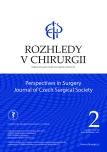New options for surgeons to improve malnutrition in the outpatient setting
Authors:
T. Skoblej 1; P. Schwarz 1; I. Satinský 1,2
Authors‘ workplace:
Mezioborová jednotka intenzivní péče − pro chirurgické obory, Nemocnice Havířov
1; Ústav ošetřovatelství, Fakulta veřejných politik, Slezská univerzita v Opavě
2
Published in:
Rozhl. Chir., 2021, roč. 100, č. 2, s. 60-65.
Category:
Review
Overview
Malnutrition is a significant negative factor for surgical patients in the entire perioperative period. However, this factor can be controlled and is easy to detect in the outpatient setting. Starting from May 1, 2020, surgeons have the possibility to prescribe sipping under certain conditions for a limited period of 4 weeks. Thereby they have become able to strongly impact any altered nutritional status both preoperatively and postoperatively. The authors describe scoring questionnaires used for the detection of malnutrition and required by health insurance companies. Additionally, prescribing conditions and potential mistakes in the outpatient setting are analysed.
Keywords:
surgical patient – malnutrition – sipping − prescription
Sources
- Buzby GP, Mullen JL, Matthews DC, et al. Prognostic nutritional index in gastrointestinal surgery. Am J Surg. 1980;139 : 160−167. doi:10.1016/0002-9610(80)90246-9.
- Detsky AS, Baker JP, O´Rourke K, et al. Predicting nutrition-associated complications for patients undergoing gastrointestinal surgery. J Parent Enteral Nutr. 1987;11(5):440−446. doi:10.1177/0148607187011005440.
- Dempsey DT, Mullen JL, Buzby GP. The link between nutritional status and clinical outcome: can nutritional intervention modify it? Am J Clin Nutr. 1988;47 : 352−356. doi:10.1093/ajcn/47.2.352.
- Daley J, Khuri SF, Henderson W, et al. Risk adjustment of the postoperative mortality rate for the comparative assessment of the quality of surgical care: results of The national veterans affairs surgical risk study. Am Coll Surg. 1997;185(4):328−340.
- Howard L, Ashley C. Nutrition in the perioperative patient. Annu Rev Nutr. 2003;23 : 263−282. doi:10.1146/annurev.nutr.23.011702.073353.PMID: 14527336.
- Singer P, Blase AR, Berger MM, et al. ESPEN guideline on clinical nutrition in the intensive care unit. Clin Nutr. 2019;38(1):48−79. doi:10.1016/j.clnu.2018.08.037.
- Taylor BE, McClave SA, Martindale RG, et al. Guidelines for the provision and assesment of nutrition support therapy in the adult critically ill patient: Society of Critical Care Medicine (SCCM) and American Society for Parenteral and Enteral Nutriton (A.S.P.E.N.). Crit Care Med. 2016;44(2):390−438. doi:10.1186/s13054-020-2739-4.
- Weimann A, Braga M, Carli F, et al. ESPEN guidelines: Clinical nutrition in surgery. Clin Nutr. 2017;36(3):623−650. doi:10.1016/j.clnu.2017.02.013.
- Státní ústav pro kontrolu léčiv [online]. Praha: SÚKL, 2020 [cit. 24.6.2020]. Available from: https://verso.sukl.cz/fcgi/verso.fpl?fname=vp_pisemnost&_idspis=176815371&_idpis=424072261.
- Kondrup J, Rasmussen HH, Hamberg O, et al. Nutritional risk screening (NRS 2002): a new method based on an analysis of control clinical trials. Clin Nutr. 2003;22(3):321−336. doi: 10.1016/s0261-5614(02)00214-5.
- Stratton RJ, Hackstone A, Longmore D, et al. Malnutrition in hospital outpatients and inpatients: prevalence, concurrent validity and ease of use of the „malnutrition universal screening tool“ („MUST“) for adults. Br J Nutr. 2004;92 : 799−808. doi: 10.1079/BJN20041258.
- Guigos Y, Vellas B, Garry PJ. Assessing the nutritional status of the elderly. The Mini Nutritional Assessment as part of the geriatric evaluation. Nutr Rev. 1996;54(1):S59−S65. doi: 10.1111/j.1753-4887.1996.tb03793.
- Česká onkologická společnost [online]. Praha, ČOS 2013. Available from: https://www.linkos.cz/ceska-onkologicka-spolecnost-cls-jep/organizace-cos/pracovni-skupiny-cos/pracovni-skupina-nutricni-pece-v-onkologii-pri-cos/materialy-pro-praxi-ke-stazeni/.
- Poulia KA, Yannakoulia M, Karageorgou D, et al. Evaluation of the efficacy of six nutritional screening tools to predict malnutrition in the elderly. Clin Nutr. 2012;31(3):378−385. doi: 10.1016/j.clnu.2011.11.017.
- Kaiser MJ, Bauer JM, Ramsch C, et al. Validation of the Mini Nutritional Assessment short-form (MNA-SF): a practical tool for identification of nutritional status. J Nutr Health Aging. 2009;13(9):782−788. doi: 10.1007/s12603-009-0214-7.
- Guigoz Y. The Mini Nutritional Assessment (MNA) review of the literature. What does it tell us? J Nutr Healt Aging 2006;10(6):466−487.
- Vellas B, Villars H, Abellan G, et al. Overview of the MNA. Its history and challenges. J Nutr Healt Aging 2006;10(6):456−465.
- Státní ústav pro kontrolu léčiv [online]. Praha, SÚKL 2020. Available from: http://www.sukl.cz/sukl/seznam-cen-a-uhrad-lp-pzlu-k-1-5-2020.
- Česká chirurgická společnost [online]. Praha, ČCHS 2020. Available from: https://www.chirurgie.cz/sekce-spolecnosti/sekce-intenzivni-pece-pro-chirurgii/dokumenty/dokumenty-ke-stazeni/.
- Česká společnost klinické výživy a intenzivní metabolické péče [online]. Praha, SKVIMP 2020. Available from: https://www.chirurgie.cz/sekce-spolecnosti/sekce-intenzivni-pece-pro-chirurgii/dokumenty/dokumenty-ke-stazeni/.
Labels
Surgery Orthopaedics Trauma surgeryArticle was published in
Perspectives in Surgery

2021 Issue 2
Most read in this issue
-
Perioperative nutrition in the light of guidelines
(and in the shadow of practice) - Intermittent feeding in intensive care – the theory and practice
- Rectal cancer – current treatment strategy and the tumor regression grade evaluation after neoadjuvant therapy in patients who underwent surgery at the I. Department of Surgery, General University Hospital in Prague between 2012 and 2016
- Nutrition in open abdomen
